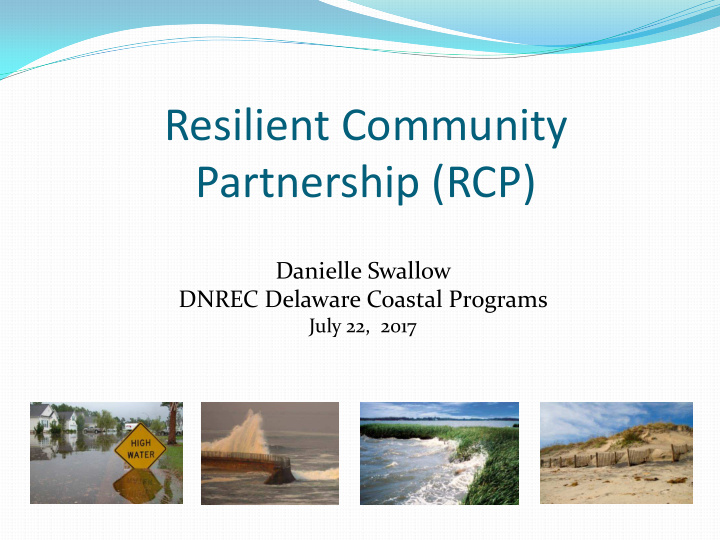



Resilient Community Partnership (RCP) Danielle Swallow DNREC Delaware Coastal Programs July 22, 2017
Definition of Coastal Resiliency: The ability of a community to bounce back after hazardous events like hurricanes and coastal storms.
Resilient Community Partnership : GOAL: To help communities undertake the necessary planning to become more resilient to coastal hazards DNREC Capabilities: • Resilience planning and coastal management • Coordination with federal and state partners • Data analysis and other technical assistance • GIS mapping • Meeting facilitation • Public education and outreach
Slaughter Beach Has An Abundance of Water
Coastal Hazards That Cause Flooding • Tropical Storms • Nor’easters • Heavy Precipitation • Extreme Tides • Sea Level Rise Nuisance Flood
Other Coastal Hazards Extreme Heat • Wildfires •
Step 1 of Our Project – Community Inventory of Assets and Values • What makes the community a special place to live in, and why? Values Survey • What infrastructure and assets are critical to the continuity of Town operations and/or quality of life? • Identify location and elevation of infrastructure like roads and propane tanks
Step 2 – Vulnerability Assessment Identify and characterize existing and future hazards Past history: FEMA Floodplain maps, Town’s experience with actual events Future: DNREC sea level rise scenarios, climate trends for heat Document potential impacts of each hazard on assets and prioritize the hazards
Step 3 – Adaptation and Mitigation Avoid Protect Accommodate
Scope of Project 20 Years • Extreme Heat • Flooding caused by: • Hurricanes • Tropical Storms • Nor’easters • Extreme Tides • Sea Level Rise • Heavy Precipitation Events •
Steps to Date – • Inventoried community infrastructure, assets, and values • June workshop collected resident and stakeholder data • Data analysis and risk characterization • Past history, recent history, and future trends
(Past History) Indicates areas of high, moderate, low risk based on an analysis of past flooding events
FIRMs do not account for: Future conditions such as changes in storm climatology and sea level rise Shoreline erosion, wetland loss, subsidence Upland development or topographic changes Degradation or settlement of levees and floodwalls The effects of multiple storm events One map will not suffice
(Present History) • Based on feedback from first public workshop • Depicts average extent of flooding as recorded by YOU • Mainly depicts recent events such as Snowstorm Jonas and the October 2015 storm • More marsh-side flooding reported as compared to Bay-side flooding • Sufficient data to build a flood contour line for marsh side
Flood Contour Map: Intersection of Slaughter Beach Road and Bay Avenue Dark Blue Line = Average extent of flood risk from marsh side, based on recent events. Light Blue Line will be discussed shortly. Blue X = locations of Bay flooding based on recent events
Local sea levels are rising at twice the global average Global rate = 1.7 mm/yr Lewes, DE rate = 3.41 mm/yr
The rate of sea level rise is very likely to accelerate in the future 4.9 ft 3.3 ft 1.6 ft 1 ft SLR
Adaptation and Mitigation Options Fall Into 4 Main Categories Avoid Protect Accommodate Retreat
And are implemented in different ways… • Comprehensive Plan updates • Town codes and ordinances • Zoning designations • Design and engineering projects • “Grey” and “Green” infrastructure • Outreach and education • Changes in behavior Some examples follow….
Flood Contour Map: North Bay Avenue Dark Blue Line = Average extent of flood risk from the marsh, based on recent events. Light Blue Line = 1 ft of sea level rise added to flood line on marsh side. Blue X = locations of Bay flooding
Flood Contour Map: Bay Avenue to Cedar Beach Road Dark Blue Line = Average extent of flood risk from the marsh, based on recent events. Light Blue Line = 1 ft of sea level rise added to flood line on marsh side. Blue X = locations of Bay flooding
Let’s Talk Heat… Average temperatures are increasing in Delaware Statewide Mean Annual Temperature 1895 - 2012 60 Mean Annual Temp. (F) 58 56 54 52 +0.2 o F per decade in every season but Fall 50 Source: Dr. Dan Leathers, Delaware State Climatologist
Adaptation and Mitigation Projects are carried out at different scales: Federal State County Community Property Owner
Community resiliency begins with YOU : Know Your Risks Plan for the future Act NOW Photos courtesy of Amy Parker and Bill McSpadden
Questions/Comments? Please visit our tables and experts Interested in being in a focus group in December or January? Sign in sheet at the lunch ticket table Inventory of first floor elevations, a/c units, and propane tanks – please visit Adaptation table
“Safeguarding our heritage through conservation, education, and the sharing of our abundant natural resources.” YOUR input led to the creation of this final Vision Statement for Slaughter Beach. Thank you for your feedback!
Recommend
More recommend